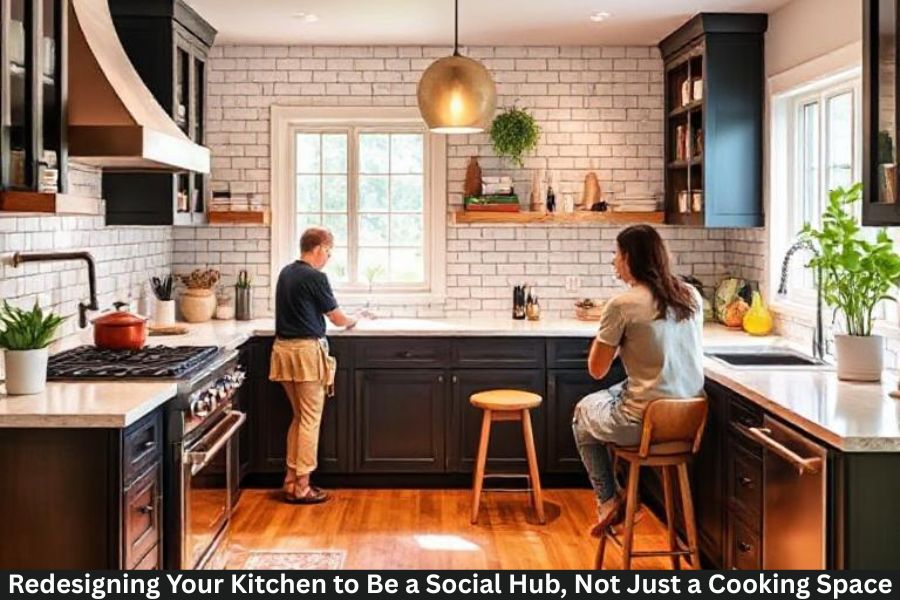
Ever noticed how everyone ends up in the kitchen during parties, family gatherings, or even casual hangouts? It’s no coincidence—kitchens naturally pull people together. But today, kitchens aren’t just about chopping vegetables or stirring pots. They’re evolving into warm, welcoming social hubs where memories are created just as often as meals.
Why Modern Kitchens Are Becoming Social Spaces
With open-concept homes on the rise, kitchens are becoming the center of daily life. They’re no longer hidden corners but bright, lively spaces designed for conversations, laughs, and togetherness.
The Shift from Closed Kitchens to Open, Interactive Designs
Gone are the days of walled-in kitchens. Today’s homeowners prefer open layouts that merge the kitchen with living and dining areas, encouraging communication and participation.
Understanding the Role of a Social Kitchen
More Than Food—It’s About Connection
A social kitchen invites people to interact—whether you’re cooking, sipping tea, or simply catching up.
How Kitchen Design Influences Interaction
Layout, lighting, seating, and colors all play a role in making a kitchen feel welcoming.
Key Elements of a Social-Focused Kitchen
Open Layouts
Creates a seamless flow and ensures no one feels isolated while preparing meals.
Multipurpose Islands
Great for eating, prepping, working, or chatting.
Integrated Seating Spaces
Bar stools, breakfast nooks, benches—they all make the kitchen a hangout zone.
Smart Storage for a Clutter-Free Look
A messy kitchen pushes people away; a neat one invites them in.
Creating an Open and Inviting Layout
Breaking Down Barriers (Literally!)
Removing unnecessary walls instantly opens up space and encourages movement.
How to Improve Flow and Movement
Wider pathways help people navigate without bumping into each other.
Efficient Work Triangle
Your stove, sink, and refrigerator should form a smooth, functional triangle.
Space for Guests to Move Freely
Keep your social areas away from the cooking zone for safety and comfort.
Designing a Kitchen Island That Brings People Together
Types of Islands for Social Kitchens
- L-shaped islands
- Waterfall countertop islands
- Portable islands for small kitchens
Adding Bar Stools and Casual Seating
Bar seating creates the perfect hangout spot—guests can snack, chat, or keep you company while you cook.
Integrating Appliances in the Island
Built-in microwaves, wine coolers, or sinks maximize space and functionality.
Lighting That Sets the Mood
Ambient Lighting
Sets the general tone of the kitchen.
Task Lighting
Perfect for chopping, cooking, or reading recipes.
Accent Lighting for Warmth
Adds character and depth.
Pendant Lights Over Islands
The most popular choice for social kitchens—stylish and functional.
Choosing the Right Furniture for a Social Kitchen
When Comfort Meets Function
Pick furniture that’s cozy but durable.
Dining Nooks and Built-In Seating
These create intimate gathering spots while saving space.
Materials That Enhance the Atmosphere
Wood, stone, and textured fabrics add warmth and charm.
Incorporating Technology for Social Interaction
Smart Appliances
Voice-controlled cookers, digital fridges, and touch faucets enhance convenience.
Built-In Speakers
Perfect for setting the vibe with music.
Charging Stations for Convenience
Make your kitchen the go-to hangout spot for long conversations.
Storage Solutions That Keep Your Social Kitchen Neat
Hidden Storage
Keeps countertops clean, making the kitchen look bigger.
Open Shelving for Stylish Display
Perfect for showcasing elegant dishes or decorative pieces.
Pantry Organization Tips
Bins, labels, and clear jars help you stay clutter-free.
Adding Personality Through Decor
Warm Colors
Earthy tones, pastels, or warm neutrals uplift the mood.
Plants and Natural Accents
Instantly add freshness and life.
Art Pieces That Spark Conversation
Wall art, handmade pottery, or photos make your kitchen feel unique.
Creating Zones for Cooking, Eating, and Relaxing
How to Divide Space Without Walls
Furniture placement, rugs, and lighting can help define zones.
The Importance of Assigning Purposes to Each Area
Clear zones reduce clutter and improve the overall flow.
Safety Considerations in Social Kitchens
Proper Ventilation
Keeps air fresh and removes cooking odors.
Child-Friendly Design Choices
Rounded corners, high-placed appliances, and slip-free floors are must-haves.
Fire-Safe Appliances
Helps prevent accidents, especially in busy kitchens.
Budget-Friendly Tips to Transform Your Kitchen
Small Changes with Big Impact
New cabinet handles, a fresh coat of paint, or updated lighting can change everything.
Affordable Decor Ideas
Plants, wall shelves, and DIY art go a long way.
DIY Organization Solutions
Use baskets, drawer dividers, and magnetic strips for easy sorting.
Real-Life Examples of Social Kitchen Makeovers
Compact Apartment Kitchens
Open shelving and foldable furniture work wonders.
Family Homes
Larger islands, cozy dining areas, and lots of seating options.
Luxury Modern Homes
High-end appliances, ambient lighting, and seamless integration with living spaces.
Conclusion
A kitchen isn’t just a place to flip pancakes anymore—it’s where conversations happen, ideas grow, and families bond. Redesigning your kitchen into a social hub doesn’t require a massive budget. With thoughtful planning, the right layout, and a sprinkle of creativity, you can transform your kitchen into the warm, inviting heart of your home.
FAQs
1. What makes a kitchen a social hub?
A mix of layout, lighting, seating, and inviting design elements encourages interaction.
2. Do I need a big kitchen to create a social space?
Not at all—smart use of space and multifunctional furniture work even in small areas.
3. What lighting is best for social kitchens?
A combination of ambient, task, and accent lighting creates the perfect vibe.
4. How do I create a cozy atmosphere?
Warm colors, natural materials, soft lighting, and plants make your space feel welcoming.
5. Should my kitchen island have seating?
Absolutely—seating turns your island into a conversation and gathering spot
